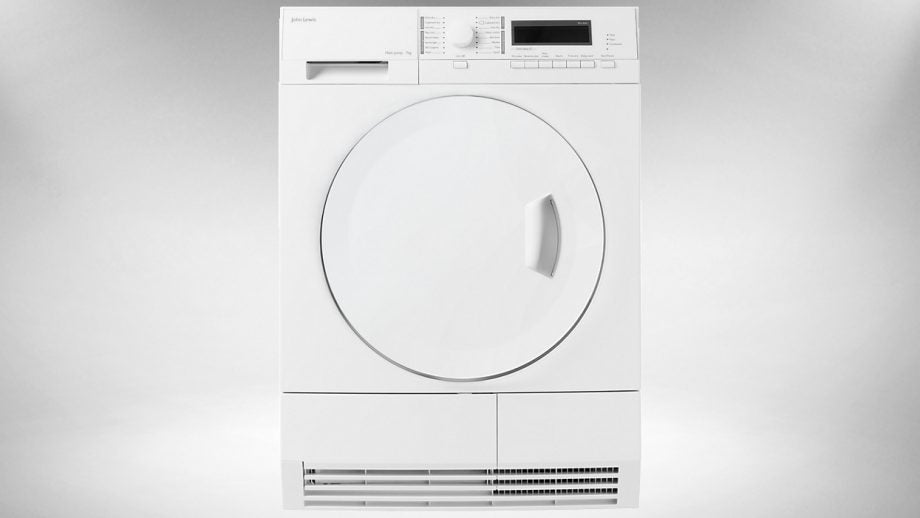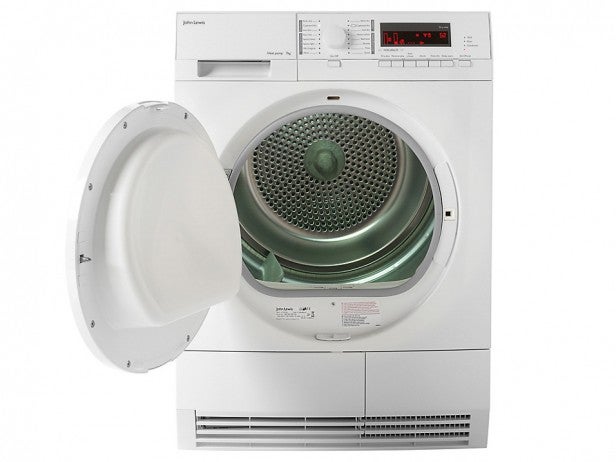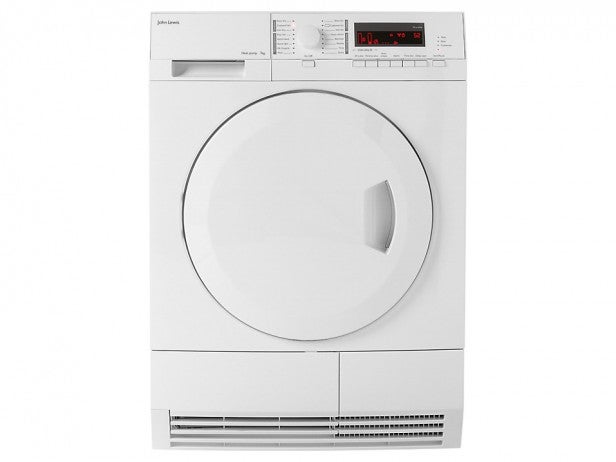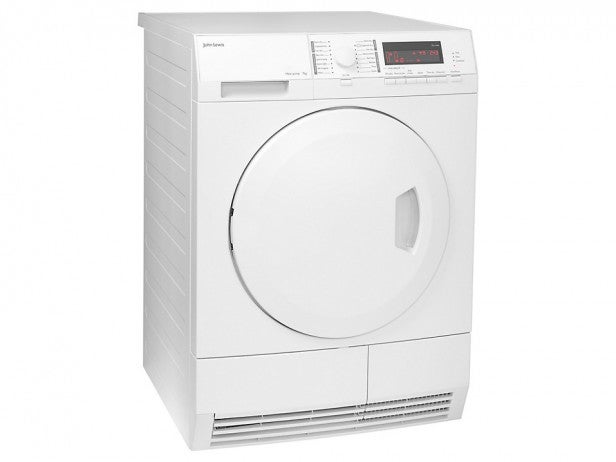John Lewis JLTDH18 Review
John Lewis JLTDH18
A great mid-range tumble dryer for the average family household

Verdict
Pros
- Good value for money
- Heat pump energy efficiency
- Low running costs
- Excellent drying performance
- Easy to use
Cons
- Not great with small loads
- Basic programme choice
Key Specifications
- Review Price: £419.00
- Dimension: 85 x 60 x 63cm
- 7kg maximum load
- A+ energy rating
- 66dB noise level
- Condenser type
What is the John Lewis JLTDH18?
Promising outstanding energy efficiency thanks to its high tech heat pump technology John Lewis’ own brand tumble dryer offers big capacity drying without the big electricity bills. This thoroughly up-to-date appliance packs in sensor drying, easy to clean fluff filters and wide opening door for easy loading.
Traditional ‘knob and button’ controls along with a digital display make it a breeze to use, with options for different levels of dryness. With a raft of fabric specific programmes from sports garments to bed linen, can the John Lewis JLTDH18 dry with the best big name brands?
John Lewis JLTDH18 – What is it like to use?
John Lewis appliances always get a bonus point from us for the fabulous naming protocol and the JLTDH18 (that is, John Lewis Tumble Dryer, Heat-pump) is no exception. Focusing on convenience and simplicity of use allied to reduced running costs through the use of heat pump technology, this model ticks all the boxes for a modern tumble dryer and does so at a competitive price for a top spec machine too.
Rather than going purely old-school manual knob control or cutting edge digital, the controls are a great balance of both. The large central knob selects the type of fabric and the level of dryness required, and a number of options button allow use of features such as anti-crease, dry plus or delay start as required. These selections are shown clearly on the funky bright red LED display, along with running time and symbols indicating the stage of the drying process. Three clear warning lights on the right side of the fascia let you know when you need to be emptying the water container or cleaning fluff filter and condenser.
Related: More Tumble Dryer Reviews
Loading up to 7kg (dry weight) of clothing is made easier by the enormous porthole door. This allows you to get in the largest items such as thick blankets to make the most of this machine’s dedicated bed linen drying programme. The main fluff filter is located at the bottom of the porthole and simply slides out for cleaning. A quick wipe with a sheet of damp kitchen roll cleaned it efficiently, making it easy to do this between each load.
As a condenser model there is no venting required but you will need to empty the water container and occasionally clean out the condenser itself. The water container is conveniently located at the top left where a washing machine’s soap drawer would normally reside. You simply slide the container out, empty in the sink and replace. The condenser is a large metal grid that slides out from the bottom of the machine and will need an occasional clean out too. If the filter is kept regularly buffed the condenser won’t be too messy with fluff but it takes a steady hand not to throw water all over the floor when it is removed.
As with all condenser models the JLTDH18 is best situated in your nice warm kitchen. If placed in a garage or outbuilding, the chillier temperatures will reduce efficiency, particularly through the winter when you are likely to be using it the most.
John Lewis JLTDH18 – How noisy is it?
The JLTD18 was the first appliance we have tested using our new high-tech data-logging sound pressure level test equipment. This provides noise levels every second of the entire drying cycle giving us the most accurate average noise level measurement possible.
While this John Lewis models did have very brief peaks of noise up to the 66dB stated on the EU Energy label, its running noise over most of the drying cycle was much lower than that at between 62dB and 63dB. That is nicely quiet for a tumble dryer and only about the same volume as a gentle conversation or background music from your kitchen radio. Moreover, the sound is softened by the machine’s insulation and solid door making the noise a warm drone – the sort of noise babies, and even our Labrador, will fall asleep too.

John Lewis JLTDH18 – What programmes does it have?
The JLTDH18’s programme selection is not extensive but it is well thought out for the average UK home. Alongside the regular cottons, wools and silk drying cycles, it offers specialist programmes for bed linens and blankets, as well as both lightweight and heavy duty sports garments. For families with active kids, that covers the bases although other machines in this class will add more specific programmes for items such as technical fabrics, duvets and ultra-delicates.
There are three levels of dryness available, iron dry, cupboard dry and extra dry. Iron dry leaves the clothes a little damp to the touch so that creases caused by drying are easily ironed out. The additional heat of ironing and hanging up finishes the drying process. Cupboard dry is dry enough to hang up and put straight away into the cupboard; again retaining just enough moisture that creases don’t become firmly dried in and drop out while hanging. Extra dry is useful for garments that are going to be folded up into drawers or if you are in a hurry and need to rush out of the door with your shirt still warm from the dryer.
Additional features really mark this model out as a premium dryer and include a reverse action to keep clothes separated to dry more quickly, a cool final tumble to reduce creasing and a delay start so you can make the most of cheaper night time electricity or have the clothes finish drying as you come home.
As a sensor dryer, this machine constantly monitors the moisture in the drying air to assess the heat and length of time required to get your load dry. So if you place in just a couple of tea towels the cycle will run for much shorter time and use much less energy than if you dry several soggy blankets straight out of the washer. Well, that’s the theory anyway. In practise it wasn’t so cut and, well, dried.
John Lewis JLTDH18 – How well does it dry?
We tested the JLTDH18 on two individual cycles. The first is a 1kg (dry weight) mixed load, typical of a light load users want to dry quickly, on the machine cotton programme and cupboard dry setting. The second load is somewhat more challenging, comprising 50% of the maximum capacity (dry weight) of mixed clothes to cupboard dry.
The easy 1kg load, containing well over half a kilo of extra water straight from the washing machine, took a rather lengthy 2hrs 5minutes to dry and used 1.01kWh of energy. Neither of those figures are particularly impressive. Most tumble heat pump dryers we have tested average under two hours and less than 1kWh of energy for this load, so clearly the JLTDH18 is not at its very best with small loads. However, the load itself came out a little on the dry side for cupboard dry (less than 1% weight of water remaining) although the counter-rotating drum and anti-crease setting did very well in keeping creases to a minimum. T-shirts in this load could easily be worn straight from the drum without looking like you have spent a night on the tiles in them.
Turning that so-so result right around the JLTDH18 produced a great result with the very wet half load (3.5kg dry weight) of mixed clothes and textiles. Taking just five minutes longer than the 1kg load and using just 1.24kWh of electricity is an excellent result and comparable with much more affluent big brand name models to dry this much washing. To put things into perspective we would expect a non-heat pump dryer to use at least twice as much electricity for the same load. Over a year that will be a big saving if you regularly use your tumble dryer. Moreover, the drying was perfect cupboard dry on this larger load with 1.4% moisture remaining to ensure a fresh feel and low crease count straight out of the drum. Perfect.
Related: Grundig GTN38240GCW review
John Lewis JLTDH18 – How much will it cost to run?
While the John Lewis’s very small load performance is poor in both over drying the clothes and energy consumption, it more than makes up for it with stellar larger load drying. Just 1.25kWh for a half load equates to less than 20p to get a good size load dry and the results are spot on thanks to the senor drying. As long as you are not the sort of person that regularly dries a single shirt in a hurry to go out, the JLTDH18 offers exceptionally economic drying. Given around 150 cycles a year, with only 25 of those being small loads, this machine will cost you less than £30 a year to run.
Should I buy the John Lewis JLTDH18?
Simple to use, genuinely useful features and economic running costs for larger loads makes this advanced heat pump tumble dryer a great buy.
However, its small load performance is questionable and it’s not exactly festooned with the latest fabric programmes. Nonetheless, overall it’s a great choice at the price for the average family household.
Verdict
A great choice for the average family household with a good balance of performance and features for the price.
Trusted Score
Other
| Power Consumption (KWh) | 1.01 |
| Cost Per Load at 15p/KWh | 15p |
| Remaining Moisture (Grams / % of load) | 3g / <1% |
| Time to Completion | 2hrs 5min |
| Max Noise | 62.5dB |
| Cupboard Dry Accuracy | Over dry |
General Info
| Drum Capacity | 7kg |
| Energy Rating | A+ |
| Approx. Annual Power Consumption (KWh) | 181.06kWh |
| Approx. Annual Running Cost | £27.16 |
50% Mixed Dry Load / 'Cupboard Dry'
| Power Used (KWh) | 1.247 |
| Running Cost per Load at (15p/KWh) | 19p |
| Moisture Remaining (Grams / % of load) | 45g / 1.4% |
| 'Cupboard Dry' Accuracy | Perfect |
| Time to Finish | 2hrs 10min |
| Noise Max Spin | 62.5dB |


